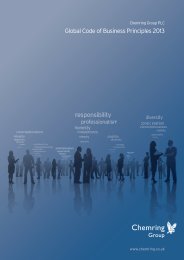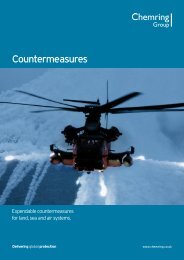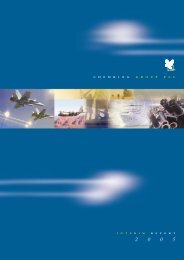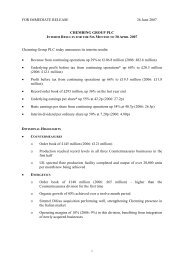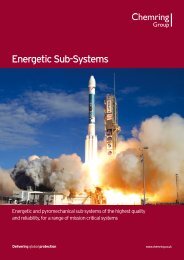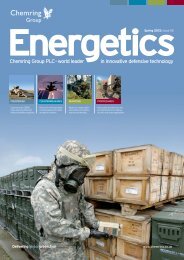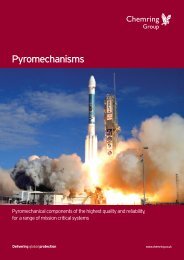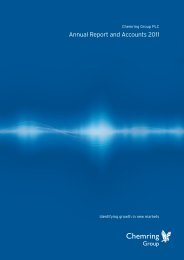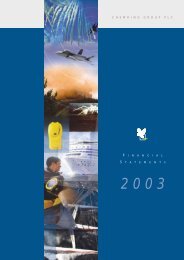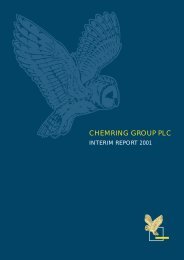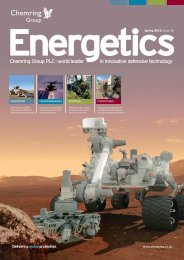Chemring Interim 2006 - Chemring Group PLC
Chemring Interim 2006 - Chemring Group PLC
Chemring Interim 2006 - Chemring Group PLC
Create successful ePaper yourself
Turn your PDF publications into a flip-book with our unique Google optimized e-Paper software.
I N T E R I M R E P O R T 2 0 0 69. DETAIL ON IFRS CHANGES IMPACTING PUBLISHED RESULTSSignificant changes to previously reported UK GAAP figures have been made in the following areas to comply with IFRS:A) IFRS3 - Business CombinationsUnder IFRS3 there is a specific requirement to recognise separately indentifiable intangible assets that meet the IFRS3 criteriaincluding acquired order back log, customer relationships and technology assets at fair value on acquisition and to amortisethese over an appropriate period. This reduces the amount of residual goodwill recognised.As stated above, under IFRS1 business combinations prior to the date of transition are not required to be restated. The adjustmentis therefore limited to the five acquisitions completed since 1 November 2004. Specific intangible assets with a fair value of£8,769,000 were identified out of a total UK GAAP goodwill addition of £56,371,000. As at 31 October 2005 specificintangibles, net of amortisation, of £2,929,000 were identified from acquisitions at that date. A further £5,437,000, net ofamortisation, was added in the six months to 30 April <strong>2006</strong>.Total amortisation of £403,000 has been charged since the date of transition, of which £71,000 was in the period to31 October 2005 and £332,000 in the period to 30 April <strong>2006</strong>.B) IFRS2 - Share-Based PaymentsUnder IFRS2 charges are required for all share-based remuneration schemes. These charges reflect the fair value of the shares atthe date of the grant. The operating profit charge for the year to 31 October 2005 for all relevant schemes under this standardwas £477,000, with an additional operating profit charge for the six months to 30 April <strong>2006</strong> of £433,000. The opening IFRSbalance sheet net assets are reduced by £76,000. Net assets at 31 October 2005 are reduced by £328,000 and by a further£357,000 to 30 April <strong>2006</strong>.C) IAS19 - Employee Benefits and Retirement Benefit SchemesUnder IAS19 there is a requirement to recognise the monetary value of employee benefits accruing to employees but not yetsettled; typically holiday pay. There is a requirement to present the value of the liability for employee benefits to be paid in thefuture for services provided up to the reporting date. A review of employee benefits across the <strong>Group</strong> identified an openingbalance sheet adjustment of £518,000. A charge of £256,000 arose in the period ended 30 April <strong>2006</strong> (April 2005: £222,000).Under UK GAAP the <strong>Group</strong> accounted for defined benefit pension schemes in accordance with SSAP24, with disclosure asrequired under FRS17. Under IAS19 there is a requirement to value defined benefit scheme assets at bid price rather than midmarket price, and to disclose the retirement benefit asset/obligation on the face of the balance sheet, with movement in thevaluation of actuarial gains and losses through the statement of recognised income and expenditure (SORIE). At the date oftransition, 1 November 2004, the initial increase in non-current liabilities is £16,115,000, with a corresponding deferred taxasset of £4,835,000 reported in non-current assets. In addition, the previous SSAP24 prepayment of £252,000 has beenreversed. The impact at 30 April <strong>2006</strong> is to show an increase in non-current liabilities, due to retirement benefit obligations of£16,762,000 (April 2005: £18,051,000). The charge to the income statement under IAS19 for retirement benefits includesthree components, a service cost, the expected return on pension scheme assets and the unwinding cost of interest on thepension scheme liabilities.D) IAS10 - Events after the Balance Sheet DateThere is a requirement under IFRS to only recognise the liability for dividends that have been proposed and approved at thebalance sheet date.E) IAS21 - The Effects of Changes in Foreign Exchange RatesUnder IAS21 all foreign currency transactions and balances must be converted to the reporting entity currency at the rateapplicable on the last day of the reporting period, i.e. at the spot rate. UK GAAP permitted the use of an applicable forwardcurrency contract rate instead of the spot rate.F) IAS12 - Income TaxUnder UK GAAP deferred tax liabilities were discounted; under IFRS discounting is not permitted. The impact as at1 November 2004 was to increase deferred tax liabilities by £824,000. The tax in the income statement for the year ended31 October 2005 is £61,000 higher than it would have been under UK GAAP.Under UK GAAP deferred tax liabilities on revaluation reserves were not provided for unless the <strong>Group</strong> entered into a bindingcontract to sell the revalued assets. Under IAS12 deferred tax must be provided for. The impact is to increase deferred taxliabilities as at 1 November 2004 by £1,081,000. The <strong>Group</strong> has available capital losses to offset against any potential gainarising on these assets. The impact as at 1 November 2004 is to recognise a deferred tax asset of £1,081,000. Netting-off ofassets and liabilities is not permitted under IAS12.The reconciliation of equity at 1 November 2004 (date of transition to IFRS) and at 31 October 2005 (date of last UK GAAPfinancial statements) and the reconciliation of profit for the year ended 31 October 2005, as required by IFRS1, are givenoverleaf.P 19



